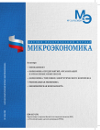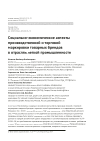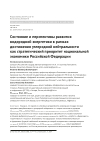Application of a functional management assessment model in conjunction with MVP and GAP analysis to improve quality management of the federal project «Building a network of modern campuses»
DOI: 10.33917/mic-2.121.2025.90-100
This article examines the organizational and economic aspects of applying the functional management assessment model in conjunction with MVP and GAP analysis to improve quality management of the federal project «Building a network of modern Campuses» in modern conditions. The communication profile of the federal project management methodology was built using a functional management assessment model.
The paper shows that GAP analysis makes it possible to identify discrepancies between the current level of quality of the educational infrastructure and the required level of quality defined by the goals of the federal project. The analysis allows you to identify key areas that require improvements, such as technical equipment, safety, accessibility for people with disabilities, shows that GAP analysis makes it possible to identify discrepancies between the current level of quality of the educational infrastructure and the required level of quality defined by the goals of the federal project. The analysis allows you to identify key areas that require improvements, such as technical equipment, safety, accessibility for people with disabilities, etc. Based on the results of the annals on the results of the analysis of the MVP model of the Mediaplan Information System, the authors came to the conclusion that the necessary quality control principles are embedded in the system and cannot be circumvented, which allows us to reduce the distance between the expectations of the target audience and stakeholders of the project and reality, and in emergency cases promptly implement changes «on the ground».
References:
1. Verstina N.G., Donskaya O.O. Comprehensive analysis of the role of a private partner in the creation of new campuses. Current tasks strategic approach and development – 2023: proceedings of the IV International Scientific Conference. Moscow, 2024. pp. 968-973.
2. Glezin D.D., Sollapov V.I. Application of SWOT and GAP analysis in the study of organizational quality management systems. Scientific Review. 2024;31(5):4177-4182.
3. Zherebtsova A.V., Lisova A.M. Models of life cycles of systems. Full lifecycle management systems for high-tech products in mechanical engineering: new sources of growth: proceedings of the All-Russian Scientific and Practical Conference. 2018. pp. 78-81.
4. Zapparov B.A., Pashina A.D., Feifer R.L., Abramov D.A. Specifics of economic planning for flexible technological product development at the regional level. Kazan Economic Bulletin. 2019;6 (44):15-19.
5. Krolkova N.A., Bolgova A.M. The possibilities of developing a consortium of minimally viable products (MVP) for large businesses in Russia. the text of the development of the method of strategic management. Issues of psychology and law. 2023;184:163-172.
6. Kuzmin A.M., Vysokovskaya E.A. GAP analysis is one of the most important methods of strategic analysis. Methods of quality management. 2021;12:53.
7. Latkov N.Yu., Ashvanyan S.K., Vidyakin A.V. Decision interview as a way to test a minimally viable product. Competitiveness in the global world: economics, science, technology. 2022;5:45-46.








